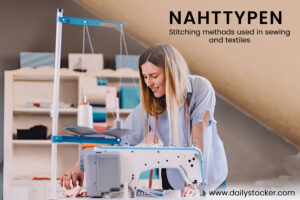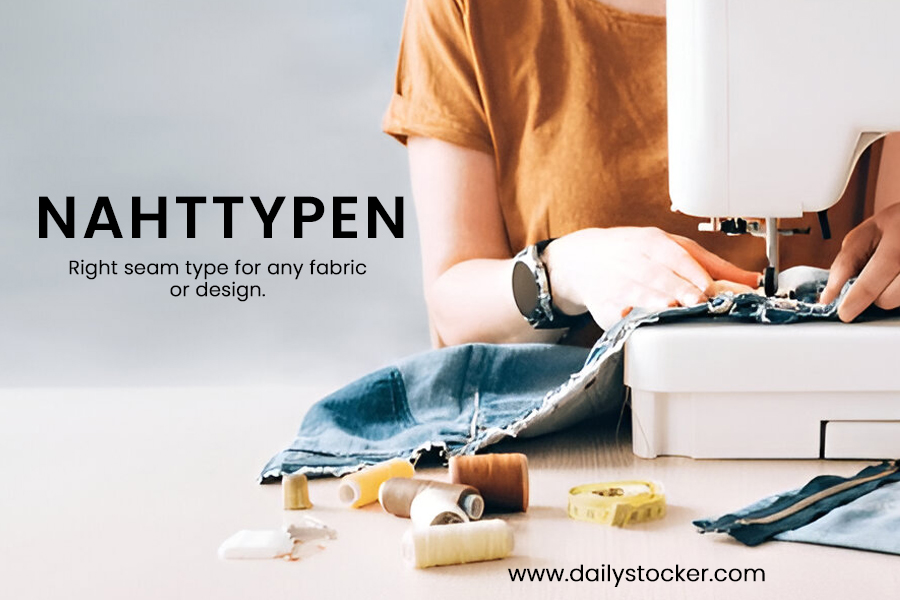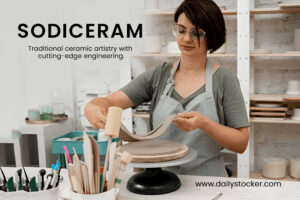Nahttypen – A Complete Guide to the Different Types of Seams in Sewing
Table of Contents
- Introduction to Nahttypen (Types of Seams)
- Understanding the Basics of Seams
- Common Types of Nahttypen and Their Uses
- Choosing the Right Nahttypen for Your Project
- Tools and Materials for Making Seams (Nahttypen)
- Step-by-Step Guide for Sewing Different Nahttypen
- Professional Tips for Stronger and Neater Nahttypen
- Common Mistakes to Avoid When Working with Nahttypen
- Advanced Seam Finishing Techniques for Professional Results
- Conclusion
- FAQ
Introduction to Nahttypen (Types of Seams)
If you’ve ever wondered what nahttypen means, here’s the simple answer: in German, “nahttypen” refers to the different types of seams used in sewing. A seam is the line where two or more pieces of fabric are stitched together, and it’s one of the most important elements in garment making, upholstery, and other textile projects. Without seams, your clothes would simply fall apart, your curtains would unravel, and your cushions wouldn’t hold their shape.
Understanding nahttypen is not just for professional tailors — it’s also essential for sewing hobbyists, fashion designers, and anyone who wants to create well-constructed, durable, and beautiful fabric items. The right seam doesn’t just keep fabric together; it also affects the strength, flexibility, comfort, and appearance of the finished product.
In this guide, we’ll take a detailed look at what seams are, why they matter, and the various nahttypen you can use for different purposes. We’ll also share practical sewing tips so you can choose and execute the perfect seam every time.
Understanding the Basics of Seams
Before we dive into the many kinds of nahttypen, it’s important to understand the basics. A seam is more than just a line of stitching — it’s the foundation of any sewn project. Whether you’re making a simple pillowcase or a high-fashion dress, the seam is the structural element that holds everything together.
What is a Seam?
A seam is created when two or more pieces of fabric are joined together by stitching. This stitching can be done by hand or, more commonly, with a sewing machine. While the main purpose of a seam is to connect fabric pieces, it also plays an important role in shaping the garment, preventing fraying, and adding decorative detail.
Why Seams Matter in Sewing
- Strength – The right seam type ensures your garment or textile item can handle regular wear and washing without falling apart.
- Appearance – Some seams are hidden inside the garment for a neat finish, while others are designed to be visible as a style feature.
- Flexibility – Certain seam types stretch with the fabric, making them perfect for sportswear or fitted clothing.
- Durability – Good seam construction prevents fraying and keeps edges secure for long-lasting use.
Main Categories of Nahttypen
Seams can be grouped into broad categories depending on their purpose and construction. Knowing these categories helps you choose the right seam for your project.
1. Open Seams
Open seams are where the fabric edges are pressed open after stitching. This method is common in lightweight fabrics and garments where a flat finish is preferred. They are easy to press and allow the fabric to drape naturally.
2. Closed Seams
In closed seams, the raw fabric edges are enclosed or stitched together to prevent fraying. They offer more durability and are often used in jeans, workwear, and items that undergo a lot of stress.
3. Decorative Seams
These seams don’t just serve a functional purpose — they are part of the garment’s design. Decorative seams may include visible stitching, piping, or other embellishments to add style.
4. Functional Seams
Functional seams are designed for specific purposes, such as waterproofing, adding stretch, or reinforcing heavy fabrics. They are common in outdoor gear, sportswear, and industrial textiles.
Common Types of Nahttypen and Their Uses
Now that we’ve covered the basics, let’s explore the most widely used nahttypen (types of seams) in detail. Each seam type has its own purpose, advantages, and ideal use cases. Choosing the right seam can make the difference between a garment that lasts for years and one that falls apart after a few washes.
Below, we’ll go through the most common seam types one by one, explaining what they are, when to use them, and how to sew them neatly.
1. Plain Seam
The plain seam is the most basic and commonly used seam type in sewing. It’s simple to construct, works on most fabrics, and is often the foundation for more complex seams.
- How it’s made: Two pieces of fabric are placed right sides together and stitched along the seam line. The raw edges are left inside the garment.
- Best for: Everyday clothing, lightweight to medium-weight fabrics.
- Tip: Always finish the raw edges with zigzag stitching or a serger to prevent fraying.
2. French Seam
The French seam is ideal for delicate fabrics and garments where a neat interior finish is essential.
- How it’s made: The raw edges are completely enclosed within two lines of stitching, giving a clean finish on the inside.
- Best for: Silk blouses, lingerie, lightweight cottons.
- Tip: Use a small seam allowance for a more refined look and to avoid bulky seams on fine fabrics.
3. Flat-Felled Seam
This seam is known for its strength and durability. You’ll often see it in jeans and heavy-duty workwear.
- How it’s made: One fabric edge is folded over the other and stitched down, completely enclosing the raw edge.
Best for: Denim, canvas, and garments that require extra strength. - Tip: Press the seam well before topstitching for a crisp, professional look.
4. Overlocked Seam (Serger Seam)
Overlocked seams are created using a serger machine, which trims the fabric edge and encloses it in thread at the same time.
- How it’s made: A serger machine uses multiple threads to bind the edge while trimming excess fabric.
- Best for: Stretch fabrics, knitwear, T-shirts.
- Tip: Choose a matching or contrasting thread color depending on whether you want the seam to be invisible or decorative.
5. Zigzag Seam
The zigzag seam is a versatile option that can be done with a regular sewing machine.
- How it’s made: A zigzag stitch is sewn over the raw edge to prevent fraying.
- Best for: Finishing seams when you don’t have a serger.
- Tip: Adjust stitch width and length based on fabric thickness.
6. Bound Seam
Bound seams add a decorative and durable finish to raw edges by enclosing them with bias tape.
- How it’s made: Bias binding is sewn over the raw edge of the seam allowance.
- Best for: Unlined jackets, skirts, and decorative garments.
- Tip: Use contrasting bias tape for a pop of color inside your garment.
7. Lapped Seam
Lapped seams are often used in sportswear and outerwear for strength and water resistance.
- How it’s made: One piece of fabric overlaps another and is stitched down with one or two rows of stitching.
- Best for: Leather, vinyl, outdoor clothing.
- Tip: Use a Teflon foot when sewing sticky materials like leather or PVC.
8. Welt Seam
A welt seam gives a strong, flat finish similar to a flat-felled seam but is faster to sew.
- How it’s made: One seam allowance is pressed to the side and topstitched, leaving one raw edge exposed inside.
- Best for: Jeans, casual jackets, uniforms.
- Tip: Great for adding strength without too much bulk.
9. Mock Flat-Felled Seam
This is a simpler alternative to the flat-felled seam, offering a similar look with less work.
- How it’s made: A plain seam is sewn, and then the seam allowance is trimmed and topstitched down.
- Best for: Lightweight fabrics where you want a decorative topstitch.
- Tip: Use contrasting thread to make the stitching stand out.
10. Pinked Seam
The pinked seam is a quick way to prevent fraying without additional stitching.
- How it’s made: Raw fabric edges are cut with pinking shears, creating a zigzag edge that resists fraying.
- Best for: Light to medium-weight woven fabrics.
- Tip: Combine with another seam finish for added durability.
Choosing the Right Nahttypen for Your Project
With so many seam types available, deciding which nahttypen to use can feel overwhelming — especially if you’re new to sewing. The good news is that there’s no one-size-fits-all rule. The right choice depends on the fabric type, project purpose, desired appearance, and durability needs. Let’s break it down step-by-step.
1. Consider the Fabric Type
Your fabric will often dictate which seam is most suitable.
- Lightweight fabrics (chiffon, voile, silk): Opt for seams that hide raw edges neatly without adding bulk, like French seams or narrow rolled seams.
- Medium-weight fabrics (cotton, linen, polyester blends): You have more flexibility. Plain seams with appropriate finishing work well, as do mock flat-felled seams for casual wear.
- Heavy fabrics (denim, canvas, upholstery materials): Go for stronger seams like flat-felled seams or lapped seams that can handle stress.
- Stretch fabrics (jersey, lycra, knits): Use overlocked seams or zigzag stitches to maintain fabric stretch without breaking stitches.
2. Think About Garment or Item Design
The style of your project can influence your seam choice.
- Formal garments: Hidden, neat seams like the French seam create a polished interior.
- Sportswear and activewear: Strong seams that can handle movement, like flat-felled or lapped seams, are ideal.
- Outerwear: Weather-resistant seams, possibly sealed or bound, add both strength and protection from the elements.
- Decorative items: Decorative seams, contrast stitching, or bound edges can be used to enhance visual appeal.
3. Factor in Durability Requirements
Some projects need seams that can withstand heavy wear and tear. For example:
- Work uniforms require flat-felled seams for strength.
- Children’s clothing benefits from seams that are both sturdy and comfortable, like mock flat-felled seams.
- Home décor items like cushions or curtains may require stronger seams to handle constant use and washing.
4. Match Seam Style with Skill Level
If you’re just starting out, it’s okay to stick with simpler seams like the plain seam or zigzag seam. As you gain confidence, you can explore more advanced nahttypen such as French seams or bound seams that require precision.
5. Don’t Forget About Seam Allowances
The width of your seam allowance matters.
- Narrow allowances are great for lightweight fabrics and delicate garments.
- Wider allowances provide more strength and allow for alterations.
Always follow pattern recommendations unless you have a specific reason to adjust.
6. Experiment and Test Before Final Sewing
A pro tip: Always make a small test sample with your chosen seam on a scrap piece of the same fabric. This helps you check:
- Stitch tension
- Seam strength
- Bulkiness
- Appearance after pressing
This simple step can save you from costly mistakes.
Why Choosing the Right Nahttypen Matters
Picking the correct seam isn’t just about appearance — it can affect how long your project lasts, how comfortable it feels, and even how easy it is to care for. A poorly chosen seam can cause puckering, fraying, or even complete seam failure over time. On the other hand, a well-chosen seam enhances fit, comfort, and longevity.
Tools and Materials for Making Seams (Nahttypen)
Creating strong, neat, and professional-looking nahttypen requires the right combination of tools and materials. While creativity and skill matter, the quality of your equipment can greatly influence your results. Let’s explore the essentials you’ll need for different seam types.
1. Sewing Machine
A good sewing machine is at the heart of making most seams.
- Basic machines handle plain seams, zigzag seams, and simple decorative stitches.
- Intermediate machines often include built-in overlock stitches, buttonholes, and stretch-friendly settings.
- Serger (Overlock machine): Specialized for overlocked seams, trimming fabric edges while wrapping them with thread for a clean finish.
- Coverstitch machine: Perfect for hemming stretch fabrics and giving a professional finish to knitwear.
Tip: Choose a machine with adjustable stitch length and width — this flexibility helps you adapt to different fabrics and nahttypen.
2. Needles
The needle is your direct connection to the fabric, so selecting the right one is crucial.
- Universal needles: Good for most woven fabrics and basic seams.
- Ballpoint needles: Designed for knits and stretch fabrics, preventing snags and skipped stitches.
- Sharp/Microtex needles: Ideal for delicate fabrics like silk or organza.
- Jeans/Denim needles: Built for heavy fabrics like denim, canvas, and upholstery.
Tip: Always change your needle regularly — a dull needle can cause skipped stitches and damage fabric.
3. Thread
Thread holds everything together, so quality matters.
- All-purpose polyester thread: Works for most sewing projects and fabrics.
- Cotton thread: Great for natural fabrics like cotton and linen; less stretch.
- Nylon or polyester-wrapped thread: Strong and durable, ideal for heavy-duty seams.
- Specialty threads: Metallic, topstitching, or upholstery threads for decorative or high-strength applications.
Tip: Match thread fiber to your fabric type for the best durability and appearance.
4. Presser Feet
Different presser feet make sewing various nahttypen easier.
- Standard presser foot: Works for most plain and zigzag seams.
- Zipper foot: Allows you to sew close to zipper teeth or piping.
- Overcasting foot: Mimics serger-style seam finishes on a regular sewing machine.
- Walking foot: Helps feed thick or slippery fabrics evenly through the machine.
5. Cutting Tools
Accurate cutting ensures seam lines match up perfectly.
- Fabric scissors: Keep these sharp and use only for fabric.
Rotary cutter: Great for precise straight-line cuts, especially in quilting. - Pinking shears: Create a zigzag edge to help prevent fraying in pinked seams.
6. Measuring and Marking Tools
Precision matters in seam construction.
- Measuring tape: For garment fitting and seam allowance checking.
- Seam gauge: Perfect for marking consistent seam allowances.
- Tailor’s chalk or fabric markers: For marking stitching lines and points without damaging fabric.
7. Pressing Equipment
Pressing your seams at every stage makes them stronger and neater.
- Iron: A must-have for pressing open seams, setting stitches, and shaping garments.
- Pressing cloth: Protects delicate fabrics from heat damage.
- Tailor’s ham: Helps press curved seams like darts and princess seams.
8. Additional Accessories
While not essential for every project, these can make seam work easier and more precise:
- Seam ripper: For fixing mistakes without damaging the fabric.
- Clips or pins: To hold fabric pieces together before stitching.
- Bias tape maker: Handy for creating bound seams.
Matching Tools to Nahttypen
Here’s a quick reference:
- French seams: Universal needle + fine polyester thread + iron for pressing.
- Flat-felled seams: Jeans needle + strong polyester thread + sturdy presser foot.
- Overlocked seams: Serger machine + multiple cones of thread.
- Bound seams: Bias tape maker + zipper foot or adjustable presser foot.
Step-by-Step Guide for Sewing Different Nahttypen
Knowing the theory behind nahttypen is one thing, but actually sewing them neatly is where the real skill comes in. In this section, we’ll walk through how to sew some of the most common seam types, step-by-step. Whether you’re a beginner or an experienced sewist, following these instructions will help you get professional-quality results every time.
1. Plain Seam
Best for: Everyday sewing, most woven fabrics.
Steps:
- Place two fabric pieces right sides together.
- Align the edges along the seam line.
- Pin or clip the fabric in place to avoid shifting.
- Set your sewing machine to a straight stitch (about 2.5 mm stitch length).
- Sew along the seam line, keeping a consistent seam allowance (usually 1.5 cm or as instructed in the pattern).
- Press the seam open with an iron for a neat finish.
- Finish raw edges with zigzag stitching, pinking shears, or an overlock stitch.
Pro Tip: Use a seam guide or seam gauge for accuracy.
2. French Seam
Best for: Delicate fabrics like chiffon, silk, and lightweight cotton.
Steps:
- Place fabric wrong sides together (opposite of most seams).
- Sew a narrow seam (about 0.6 cm).
- Trim the seam allowance to about 0.3 cm to reduce bulk.
- Press the seam flat, then fold along the stitching so right sides are together.
- Sew again with a slightly wider seam allowance (about 0.6–0.8 cm), enclosing the raw edges inside.
- Press to one side for a smooth finish.
Pro Tip: Keep stitches straight and narrow for a refined look.
3. Flat-Felled Seam
Best for: Jeans, workwear, sportswear.
Steps:
- Place fabric wrong sides together.
- Sew a straight seam with your desired seam allowance (often 1.5 cm).
- Trim one seam allowance down to about 0.5 cm.
- Fold the wider seam allowance over the trimmed one, enclosing the raw edge.
- Press flat, then topstitch close to the folded edge.
- Add a second row of topstitching if desired for extra strength.
Pro Tip: Use heavy-duty thread for durability.
4. Overlocked Seam (Serger Seam)
Best for: Stretch fabrics and raw edge finishing.
Steps:
- Set up your serger with 3–4 threads.
- Place fabric pieces right sides together.
- Align edges with the serger knife to trim slightly as you sew.
- Guide fabric smoothly without pulling to avoid stretching the seam.
- Press seam allowance to one side after sewing.
Pro Tip: Adjust differential feed to prevent puckering on knits.
5. Zigzag Seam
Best for: Preventing fraying without a serger.
Steps:
- Place fabric right sides together and sew a straight seam.
- Switch machine to zigzag stitch (width: 3–4 mm, length: 2–3 mm).
- Sew along the raw edge to prevent fraying.
- Press open or to one side depending on garment design.
Pro Tip: Match thread color for a subtle finish or use contrast for a decorative edge.
6. Bound Seam
Best for: Decorative finishing and unlined garments.
Steps:
- Sew a plain seam as usual.
- Cut bias tape long enough to cover the seam allowance.
- Wrap bias tape over the raw edge and pin in place.
- Stitch close to the bias tape edge, securing it around the seam.
- Press for a neat finish.
Pro Tip: Use patterned bias tape for a hidden pop of color inside the garment.
7. Lapped Seam
Best for: Leather, vinyl, and waterproof garments.
Steps:
- Overlap fabric edges by your chosen seam allowance.
- Pin or clip in place (use clips for leather to avoid holes).
- Topstitch along the overlap edge.
- For extra strength, add a second row of stitching.
Pro Tip: Use a Teflon presser foot for sticky fabrics.
8. Welt Seam
Best for: Durable garments with less bulk than flat-felled seams.
Steps:
- Sew a plain seam with fabric right sides together.
- Press both seam allowances to one side.
- Topstitch along the folded seam allowance, securing both layers.
Pro Tip: Great for casual jackets or trousers where you want durability without the extra weight.
General Seam-Sewing Tips
- Always press seams after sewing — it sets the stitches and improves appearance.
- Use matching thread for invisible seams, contrasting thread for decorative ones.
- Trim excess bulk where necessary to keep seams flat.
- Test on scrap fabric before sewing your final piece.
Professional Tips for Stronger and Neater Nahttypen

Sewing a seam is one thing — sewing a professional-quality seam is another. The difference often lies in the small details: how you handle the fabric, the settings you choose, and the finishing touches you add. In this section, we’ll share tried-and-tested techniques to make your nahttypen stronger, cleaner, and more polished.
1. Press at Every Step
Pressing is not just for the final stage — it’s something you should do after every seam you sew.
- Why it matters: Pressing sets the stitches into the fabric, helps the seam lay flat, and prevents puckering.
- Pro tip: Use steam for most fabrics, but avoid it for delicate materials like silk where moisture can leave marks.
2. Match the Stitch to the Fabric
Different fabrics require different stitch types and lengths.
- Lightweight fabrics: Use shorter stitches (around 1.8–2 mm) for a delicate, smooth finish.
- Medium-weight fabrics: Standard 2.5 mm stitch length works well.
- Heavy fabrics: Longer stitches (around 3 mm) prevent bulk and allow fabric to feed smoothly.
3. Secure Your Seams
Don’t forget to reinforce the start and end of each seam.
- Backstitching: Run the machine in reverse for 2–3 stitches at both ends.
- Lockstitch (on some machines): Automatically secures stitches without reversing.
- Tie-off by hand: For delicate fabrics where backstitching might cause puckering.
4. Use the Right Thread Tension
Improper thread tension can cause loops, puckering, or weak seams.
- Test on a scrap of your project fabric before sewing the actual seam.
- Adjust until both upper and lower threads lie flat without pulling.
5. Finish Raw Edges Properly
Even if your fabric doesn’t fray much, finishing the edges improves seam durability and looks.
- Options: Overlock, zigzag, pinking, or binding.
- Pro tip: For high-end garments, choose a finish that matches the style and quality of the piece.
6. Align Fabric Accurately
Poorly aligned edges lead to uneven seams.
- Use pins or clips to hold pieces in place.
- Mark seam lines on tricky fabrics with tailor’s chalk.
- Check alignment before sewing each section.
7. Reduce Bulk in Heavy Seams
When working with thick fabrics or multiple seam layers:
- Trim seam allowances where possible.
- Grade the layers (cut each layer slightly narrower than the one above it).
- Hammer lightly (with a pressing tool or mallet) to flatten the seam before topstitching.
8. Choose the Correct Presser Foot
Different presser feet can make a big difference in seam quality:
- Walking foot: Evenly feeds multiple layers.
- Zipper foot: Allows close stitching along edges.
- Overcasting foot: Helps neatly finish edges on a regular machine.
9. Maintain Your Sewing Machine
A well-maintained machine ensures smooth, even stitching.
- Clean lint from the bobbin case regularly.
- Oil your machine according to the manufacturer’s instructions.
- Change needles frequently to avoid skipped stitches.
10. Take Your Time
Rushing is the easiest way to make mistakes. Slow, steady stitching results in straighter, neater seams.
7. Common Mistakes to Avoid When Working with Nahttypen
Even the most experienced sewists can make errors when working with different nahttypen (types of seams). Understanding these mistakes and learning how to avoid them can save time, materials, and frustration.
7.1 Skipping Fabric Preparation
One of the most common issues is failing to pre-wash and iron fabrics before sewing. Fabrics can shrink, stretch, or distort after washing, which can affect the alignment of your seams. Always prepare your fabric before starting to ensure the final seam remains neat and durable.
7.2 Choosing the Wrong Seam for the Fabric
Not all seam types are suitable for every fabric. For example, a French seam works beautifully on lightweight fabrics but can be bulky and unattractive on thick denim. Matching the nahttypen to the fabric type ensures better results both in strength and aesthetics.
7.3 Incorrect Seam Allowance
Overlooking the correct seam allowance can cause fit issues in garments or weaken the structure in home décor projects. Different nahttypen require different allowances, so always check your pattern or project instructions before cutting the fabric.
7.4 Using the Wrong Thread or Needle
Your choice of thread and needle greatly affects seam performance. Heavy-duty fabrics need thicker threads and stronger needles, while delicate fabrics require fine threads and sharp, thin needles to prevent damage.
7.5 Neglecting to Finish Raw Edges
Leaving raw edges unfinished can lead to fraying and reduced seam durability. Even if you’re in a rush, make sure to finish your seams using serging, pinking shears, zigzag stitches, or other suitable edge-finishing methods.
7.6 Forgetting Pressing Between Steps
Pressing seams at each stage helps them lay flat, align better, and create a polished look. Skipping this step can make seams look bumpy and uneven, especially with more structured nahttypen.
8. Advanced Seam Finishing Techniques for Professional Results
If you want your sewing projects to have a high-end, professional look, mastering advanced seam finishing techniques is essential. These methods go beyond basic seam construction and help ensure durability, neatness, and style.
8.1 Binding Seams
Binding seams with bias tape or fabric strips is an excellent way to add both strength and style. This technique is especially useful for unlined garments or projects where the inside will be visible. Binding covers raw edges completely, preventing fraying and adding a decorative element.
Best For: Jackets, skirts, unlined dresses, and home décor projects.
8.2 Flat Felled Seams
Flat felled seams are known for their strength and clean finish. They involve folding one seam allowance over the other and stitching it flat, enclosing all raw edges inside. This technique is common in jeans and sportswear because it’s strong, smooth, and resists fraying.
Best For: Denim, workwear, children’s clothing, and sportswear.
8.3 Hong Kong Finish
The Hong Kong finish is a couture-level seam finishing technique often used in high-end garments. It involves binding seam allowances with bias-cut fabric strips, but unlike traditional binding, it is done in a way that adds minimal bulk.
Best For: Jackets, coats, formal wear, and tailored garments.
8.4 French Binding
Similar to the Hong Kong finish but with a softer, more delicate feel, French binding is ideal for lightweight fabrics. It adds elegance to the interior of the garment and is perfect for projects where aesthetics matter inside and out.
Best For: Silks, chiffons, and fine cottons.
8.5 Double-Stitched Seams
Double stitching adds extra strength to high-stress seams, making them more resistant to tearing. It’s often combined with topstitching for additional reinforcement and visual appeal.
Best For: Activewear, outdoor gear, and heavy-use items.
8.6 Serged Seams with Decorative Threads
Modern sergers allow you to use decorative threads to create colorful seam finishes. This is an excellent way to make interior seams stand out, especially in reversible garments.
Best For: Reversible jackets, children’s clothes, and statement fashion pieces.
Pro Tip for All Techniques:
When using advanced seam finishes, take the time to test them on scrap fabric first. This ensures that the thickness, stitch type, and tension are suitable for your fabric before applying them to your main project.
9. Nahttypen in Different Sewing Projects
Different sewing projects often require specific seam types to achieve the best results in terms of durability, comfort, and appearance. Let’s explore which nahttypen work best for various categories.
9.1 Clothing
When sewing garments, comfort and flexibility are just as important as strength. Seam choices depend heavily on the type of fabric and the style of the garment.
- French Seams – Ideal for delicate fabrics like silk and chiffon, giving garments a smooth inside finish without visible raw edges.
- Overlocked Seams – Perfect for knitwear and stretch fabrics, allowing flexibility without fraying.
- Flat Felled Seams – Great for jeans, trousers, and shirts where both durability and a neat look are required.
Example: For a summer dress made from lightweight cotton, a French seam ensures a neat, professional finish while keeping the inside smooth against the skin.
9.2 Home Décor
Home décor items often need strong, structured seams to handle frequent use and washing.
- Topstitched Seams – Add strength and decorative appeal, great for pillowcases and curtains.
- Double-Stitched Seams – Provide extra durability for heavy fabrics like upholstery.
- Bound Seams – Give a stylish, clean look for items such as table runners or placemats.
Example: For cushion covers made from thick linen, double-stitched seams prevent fraying and extend the product’s life.
9.3 Accessories
Accessories such as bags, hats, and belts need seams that can withstand weight and wear.
- Reinforced Seams – Provide extra strength for carrying loads in tote bags.
- Bias-Bound Seams – Add a decorative touch while preventing fraying in hat brims.
- Serged Seams with Decorative Thread – Perfect for reversible scarves or fabric belts for a unique finish.
Example: A denim tote bag with reinforced seams at stress points can carry heavy items without the risk of tearing.
9.4 Children’s Clothing
Kids’ clothing requires strong, flexible, and soft seams for comfort and durability.
- Overlocked Stretch Seams – Allow movement without breaking stitches.
- Flat Seams – Reduce bulk and prevent irritation on sensitive skin.
- Double-Topstitched Seams – Keep garments secure even with frequent washing and wear.
Example: A pair of knit leggings for children works best with overlocked stretch seams to maintain comfort and shape.
10. Conclusion
Understanding nahttypen — the different types of seams — is fundamental for anyone interested in sewing, whether you’re a hobbyist, designer, or professional. The seam you choose impacts not only how your project looks but also how it performs over time. By selecting the right seam based on fabric type, project needs, and skill level, you can create durable, comfortable, and beautiful garments or textile items.
From basic plain seams to advanced finishes like flat-felled and Hong Kong seams, mastering these techniques elevates your sewing skills and opens up endless creative possibilities. Remember, quality seams start with proper preparation, the right tools, and attention to detail throughout your sewing process.
No matter your experience, experimenting with different nahttypen will help you find what works best for your projects — ensuring each stitch is a step toward professional and lasting results.
11. Frequently Asked Questions (FAQ) About Nahttypen
Q1: What does “nahttypen” mean?
A: “Nahttypen” is a German term that translates to “types of seams” in English. It refers to the various ways fabric pieces are sewn together in sewing projects.
Q2: Why is choosing the right seam type important?
A: The right seam affects the strength, durability, appearance, and comfort of the finished garment or textile item. Using an unsuitable seam can lead to fraying, tearing, or an unprofessional look.
Q3: What is the easiest seam type for beginners?
A: The plain seam is the simplest and most common seam, ideal for beginners to practice sewing because it’s straightforward and versatile.
Q4: Can I use the same seam type for all fabrics?
A: No. Different fabrics require different seams. For example, delicate fabrics often need French seams, while heavy fabrics like denim benefit from flat-felled seams.
Q5: How can I prevent seams from fraying?
A: Finish raw edges using techniques like overlocking, zigzag stitching, pinking shears, or binding to keep seams durable and neat.
Don’t miss out on any news—keep in touch for real-time information visit: DailyStocker.com
Share this content:








Post Comment